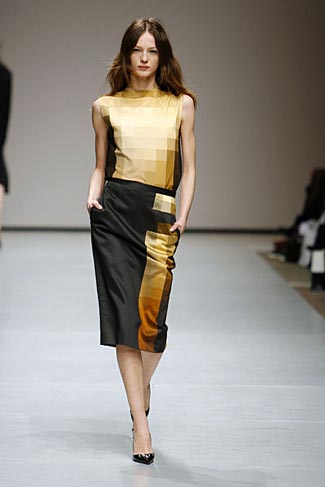Jil Sander organic cashmere caftan dress. Photo from Style.com
This review might be a week late (unfortunately due to an episode of food poisoning), yet I still feel that even after a period of rumination, I’m going to stick to my initial reaction on watching the FutureFashion show. Overall, I thought the looks were so successful that I left the show asking myself why aren’t these designers using sustainable/ethical fabrics at least most of the time? The roster of top models and designers, along with a star-studded crowd, combined to create an event that, on the surface, seemed more about the fashion scene than the serious topic of sustainability within the fashion system. Yet, rather than a mere green-washing effort, Earth Pledge and Barneys combined to create a potent opportunity for sustainable fashion to shed its crunchy overtones.
As the models came down the runway in no particular order, it was satisfying to be able to recognize instantly who created each look based on just silhouette and general feel. Twisted, clinging bias gown? Donna Karan, naturally. Pared-down effortless? Jil Sander. Impeccable, almost too-tight construction? Narciso Rodriguez. Flowing powersuit? Calvin Klein. This instant recognition is a significant indicator that a designer with a strong, clear vision can transcend the sustainability factor – just because a fabric is ethical does not mean that it is limiting.
As most of the designers stuck to a natural color palette, it was the few darker looks that I noticed most. The standout look due to its opposition to any preconceived notion of a “natural” aesthetic was the perversely romantic outfit by Boudicca made from PLA (corn polymer). As a color contrast, the ThreeAsFour dress rendered in white with a curved hem was a modern hint of the black shapes that would appear a few days later in their runway show. Martin Margiela’s corseted gown of reclaimed wedding dresses proved just how edgy patchworked lace and flowing skirts could be.
Overall, it is admirable the commitment Barneys has shown for ethical fashion. Earth Pledge (which owns the FutureFashion copyright) was wise to partner with them, not in the least because of the increased access to designers and heightened publicity for sustainable fabrics. Hopefully, each of the designers represented in the show will continue to work ethical fabrics and methods into their garments. As for now, you can see the looks in the Barneys windows at the corner of 61st Street and Madison Avenue.
Sarah Scaturro

















